After-Hours Tour of the Fraunces Tavern Museum: "Path to Liberty"
Explore a new exhibit inside the oldest building in Manhattan, a witness to history throughout the Revolutionary War Era!


Setauket, in Suffolk County, is a quaint village on Long Island dotted with numerous historic sites dating back to the 17th and 18th centuries and a natural waterfront that harkens back to the early days of American settlement. Setauket and East Setauket, located near Stony Brook, was the site of the Culper Ring, an American Revolutionary War spy ring organized by George Washington and run by Setauket residents Benjamin Tallmadge and Abraham Woodhull. The town became a national name with the AMC show TURN, which was inspired by the story of the Culper Spy Ring.
The 1777 Battle of Setauket took place at the site of the current Setauket Presbyterian Church. Many of Setauket’s structures are well-preserved and mixed with newer homes and businesses, and most of the sites on this list are accessible via walking or biking. Setauket was also the childhood home of Untapped New York’s founder Michelle Young, who lived on Strong’s Neck. Here is our guide to 12 places to discover in Setauket. On July 15th, she will be giving a virtual tour of the historic spots in Setauket for Untapped New York Insiders.

The historic Setauket post office on Main Street dates back to 1941 and designed in the Greek revival style, listed on the National Register for Historic Places. The historic post office has been in danger over the last decade, as P.O. boxes decreased to 40% occupancy, yet rallies have been held to keep it open. The community donated more than $150,000 to restore the post office building in the late 2000s. The post office sits next to Frank Melville Memorial Park, the site of the Revolutionary War’s Battle of Setauket in 1777. Real window shutters on the post office in a forest green color give it that authentic, historic feel. Inside, old PO boxes line the small lobby of the post office and you’ll be greeted by Stephanie, a long-time USPS postal worker who knows everyone’s names.
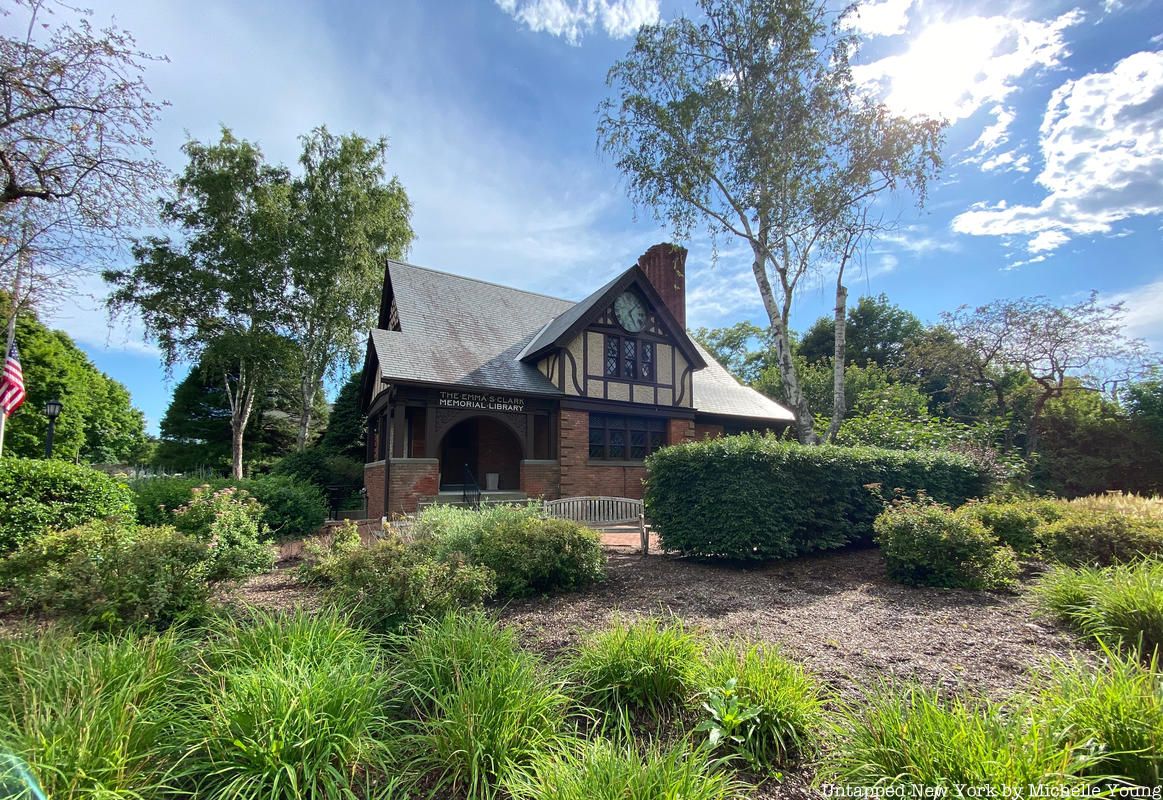
The Emma S. Clark Library is the oldest continuously-operated public library in Suffolk County, built in 1892 by patron Thomas Hodgkins. The library is named after Emma S. Clark, Hodgkins’ niece, and Hodgkins died less than 2 months after the library was dedicated.
The library is part of the Three Village Historical District. The structure stands on the property of a tavern and general store run by Thomas S. Mount, father of painter William Sidney Mount. The Tudor-style library is known for its architectural features including a four-foot clock on the facade and a lead glass window in the main reading room. It hosts many events, including an annual Local Author’s Reception featuring published authors who are from or live in the surrounding villages.

Caroline Church is one of Suffolk County’s oldest structures, erected in 1729, with its burial ground acquired in 1734. Caroline is the second oldest Episcopal church building in continuous use in the entire United States. Supposedly, the congregation had grown so large just a few years after opening that a gallery was added to the back of the church in 1744.

The Anglican church housed wounded Continental soldiers during the Battle of Setauket, and bullet holes still exist in the belfry. Services continued inside the Caroline Church during the war, although the reverend once interrupted his sermon to tell the British that their “damned Redcoats” were stealing potatoes from the church garden. The church was renovated in the mid-19th century, with the addition of a false ceiling and new furnishings, but the Melville family later led restoration efforts to return the church to its original design in the colonial style. It was added to the National Register for Historic Places in 1991, and the site also includes a horse and carriage shed that was once the site of a one-room school. For several years, the carriage shed was in danger of collapsing but funds were raised to stabilize and restore it.
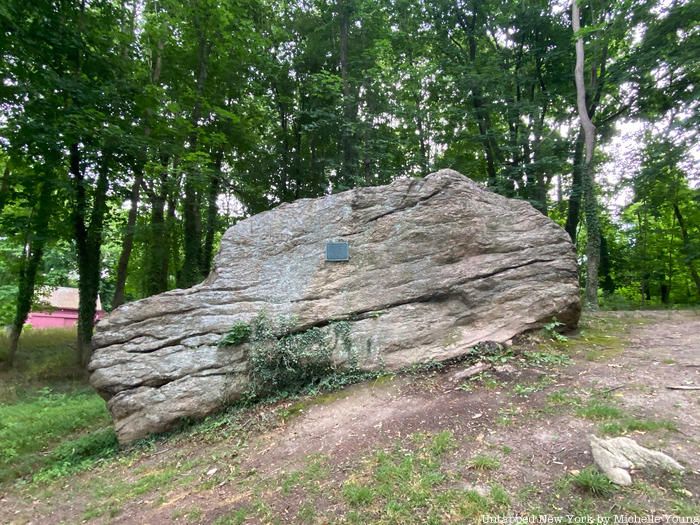
In the Old Setauket historic district is a large boulder partially hidden by woods that was left by a retreating glacier. Patriot forces used the boulder for cover during the Battle of Setauket and fired at British forces from behind it, thus giving it the name Patriot’s Rock. Additionally, Patriots mounted a canon by the rock and fired across the Village Green at the Presbyterian Church, which was fortified by Loyalist troops.

Plaque on Patriot’s Rock
The original Presbyterian Church no longer exists, but the present church was built in 1812 and contains the graves of spy Abraham Woodhull and early settler Richard Floyd. William Sidney Mount’s painting The Rock on the Green, which depicts Patriot’s Rock, hangs in the Long Island Museum of Art at Stony Brook. A plaque commemorating the 1777 “skirmish” was placed by the Mayflower Chapter of the Daughters of the Revolution in 1927.
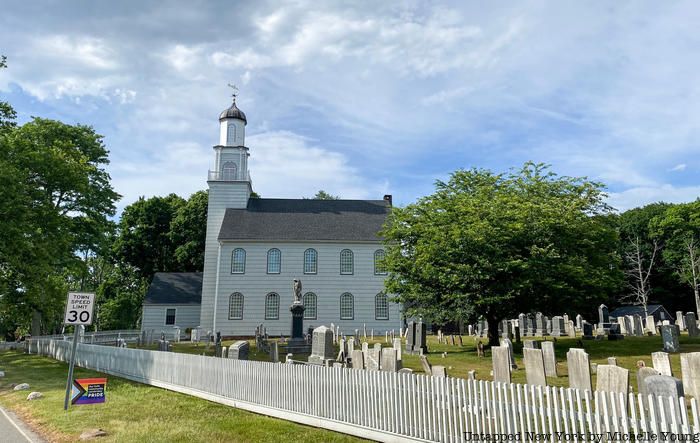
The Setauket Presbyterian Church

Roe Tavern is a historic building that originally stood on Main Street from 1703 to 1936 and now stands on a private road about a mile away. The tavern was owned by Austin Roe, a member of the Culper Ring, a spy ring established in 1778 during British occupation of New York City.
Roe worked as an alternate rider with the Culper Ring, meaning he would take messages 55 miles from Setauket to the city. He has been considered by some as the “Paul Revere of Long Island” since he traveled over 1000 miles throughout his career. A plaque on Main Street at its original location notes that George Washington, who organized the Culper Ring, stayed at the inn on the night of April 22, 1790.

The Jayne Tavern, constructed in 1750, is named after Morris Jayne, who ran the tavern following the American Revolution. It was owned by a man named John Tyler during the Revolutionary War, and a massacre took place at the tavern when British troops opened fire looking for deserters. Four Americans died in the massacre, and bullet holes can still be found at the site. It was moved in 1890 to its original location off Tavern Way off of Main Street, and it was fully restored in 1942. The house has four bedrooms with cathedral ceilings, as well as a parlor with original hand-hewn beams.

The Setauket Neighborhood House on the mill pond is a historic house that hosts a number of community events and rentals. The original home was built in the 1700s, and it was moved to its current location on Setauket Bay in 1820. After moving, the home was inhabited by Dr. John Elderkin, who passed the home on to his son John after his 1836 death.
The “Board Room” and the “Victorian Parlors” were added to the home around 1835, and it became “Ye Old Elderkin Inn” soon after, serving as a home for a stage coach line. The property was purchased in 1918 by Eversley & Minnie Childs, who added a ballroom. The Neighborhood House can be rented for educational and private events.
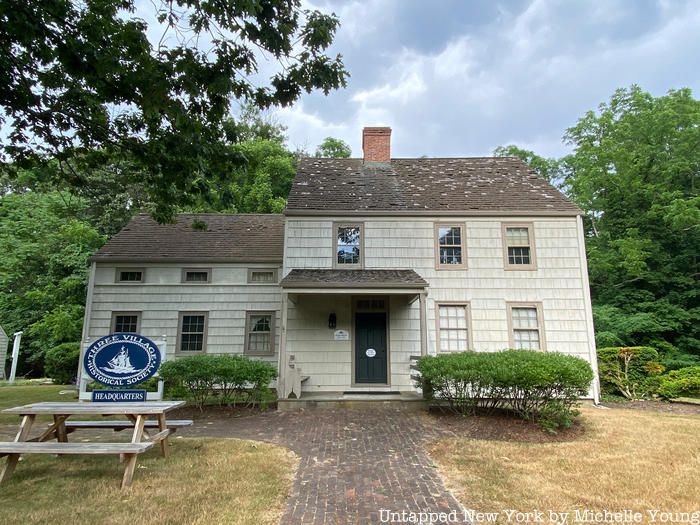
The Three Village Historical Society was founded in 1964, mainly serving the areas of Setauket, East Setauket, Stony Brook, Poquott, Head of the Harbor, and Old Field. The Historical Society is located on North Country Road in a two-story farmhouse dating to around 1800, featuring a central chimney and gable. The headquarters, referred to as the Bayles-Swezey House, was donated to the Society for the Preservation of Long Island Antiquities before being purchased by the Historical Society. In addition to in-person exhibitions on local history (closed for the next few weeks), the Historical Society also features virtual programming like a Virtual Spies! Tour, a version of their Tri-Spy Tour that passes by historic sites of the Culper Ring.

The Thompson House
Adjacent to the Bayles-Swezey House is the Thompson House, constructed around 1709 as a saltbox farmhouse. The home is named for physician and Patriot Doctor Thompson, who treated many local residents including many members of the Culper Ring. The two-story timber frame building features an asymmetrical gable roof, and it was added to the NRHP in 1988.
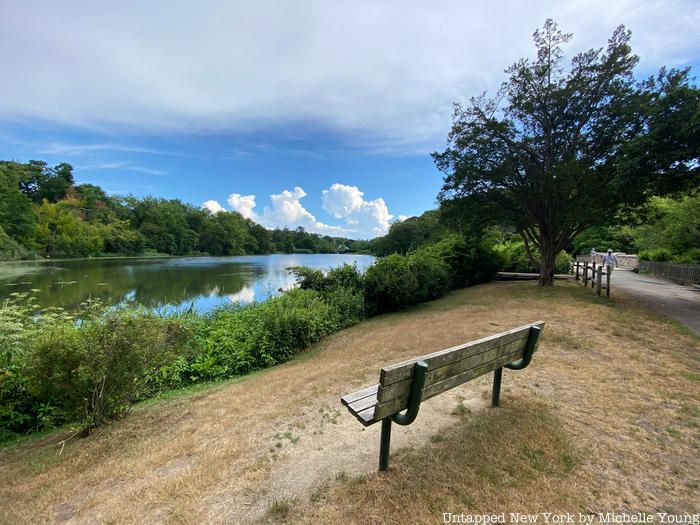
The Frank Melville Memorial Park is a publicly accessible park surrounding the Melville Mill Pond, added to the NRHP in 2010. The 24-acre park houses the Three Village Garden Club Arboretum and a walking trail. The Setauket Mill, built by Ward Melville in 1937, contains a running simulated mill wheel in the park, built near the site of other now-demolished historic mills dating back to the 1660s.

Built in the early 1700s, the Satterly Barn in the park was restored in 1968, along with the nearby John Satterly House, one of the oldest houses in Setauket. The 1922 Colonial Revival-style Bates House is also owned by the park foundation.

The home of leading Culper Ring member Abraham Woodhull no longer exists, as it burnt down in 1931, but a sign marks the spot of Woodhull’s home. The house marker notes that the original structure was constructed in 1690. The bricks of Woodhull’s old home were used to make his memorial at the Presbyterian Church and the house that stands there now is architecturally similar to the original.
Woodhull used the alias “Samuel Culper,” a play on Culpeper County, Virginia, while spying on the British. Woodhull lived by fellow leader Benjamin Tallmadge, and while living at the home, he would plan trips to Manhattan to collect information from British officers at boarding homes. Woodhull sent his findings to whaleboat operator Caleb Brewster, who took this information across the Long Island Sound to Tallmadge. Tallmadge would then hand-deliver the intelligence to General George Washington.

Tombstones of Anna and Selah Strong in the Smith-Strong Graveyard
The Smith-Strong Family Graveyard is found in Strongs Neck, a peninsula in the Setauket area that served as the home of William “Tangier” Smith, who owned much of Brookhaven. Smith’s great-granddaughter Anna was part of the Culper Ring and would eventually marry American lawyer Selah Strong. At her house in Strongs Neck, Anna communicated with spies via the color of clothes hung on her clothes line.
Anna accompanied Abraham Woodhull on one trip to New York City, since the British were less likely to suspect and search “respectable married men traveling to see in-laws with their equally respectable wives.” Today, Anna and Selah Strong are buried next to each other in the Smith-Strong Family Graveyard.

The Caleb Brewster House is considered the oldest building in the Town of Brookhaven, built in 1665. The house was the residence of seven generations of the Brewster family, including its first resident Reverend Nathanial Brewster. American Patriot Caleb Brewster was a member of George Washington’s Culper Spy Ring during the Revolutionary War, and his cousin Joseph Brewster operated the house as a tavern and general store throughout the war. It wasn’t until 1970 that the house was deeded to The Ward Melville Heritage Organization.
Next, check out 10 Beautiful Places to Discover in Suffolk County, Long Island! On July 15th, join Untapped New York founder on a virtual tour of the historic spots in Setauket for Untapped New York Insiders.
Subscribe to our newsletter